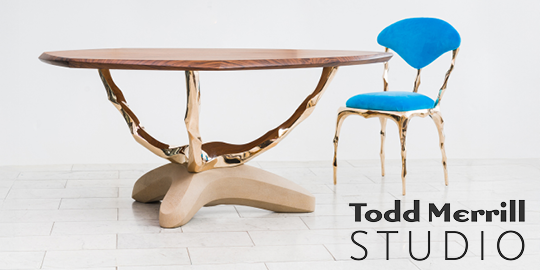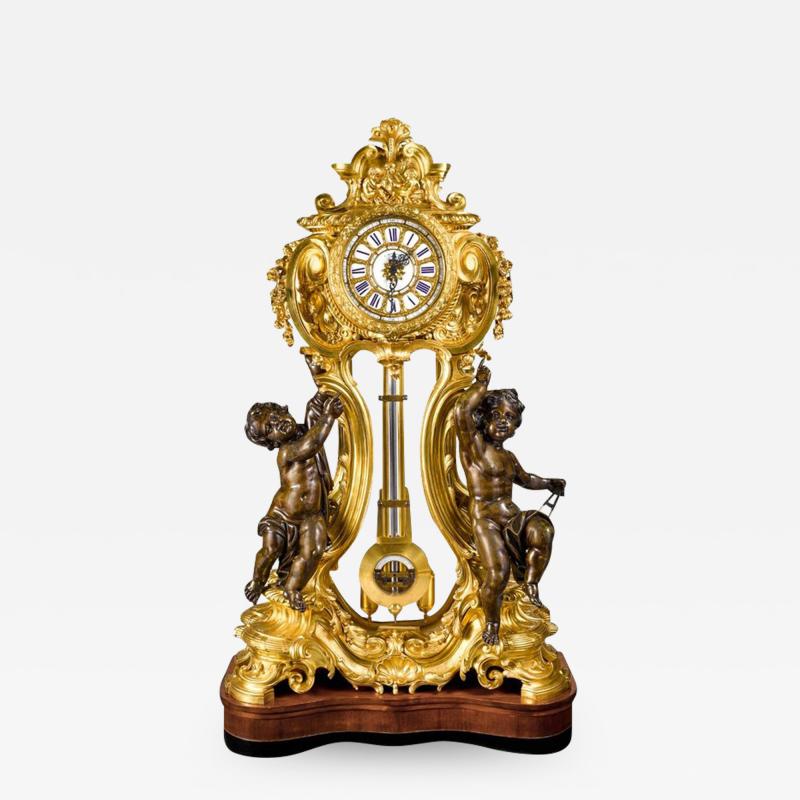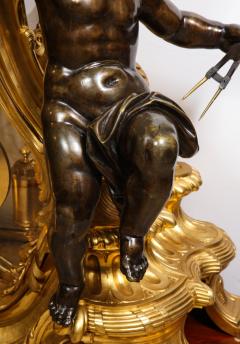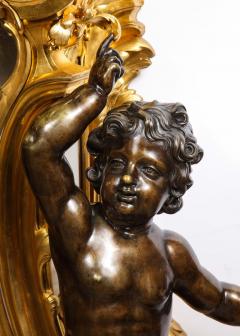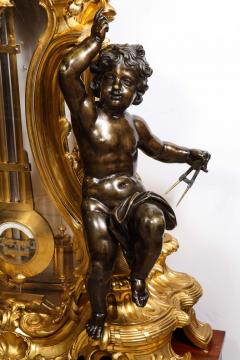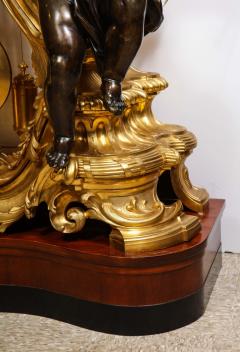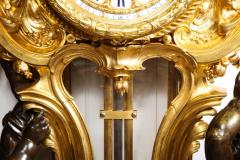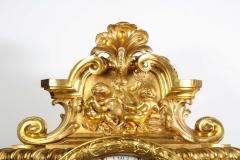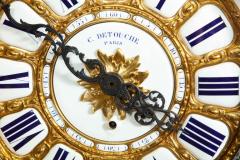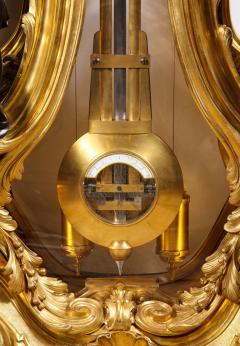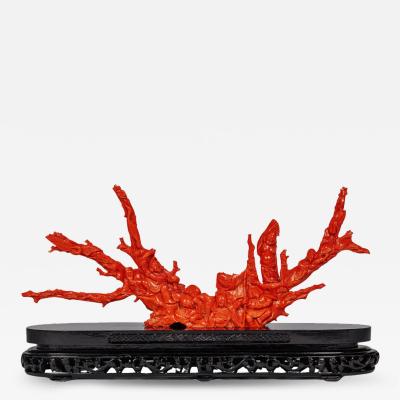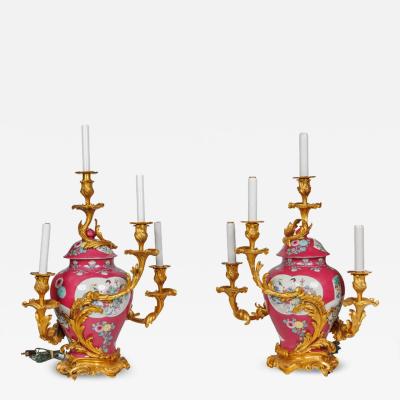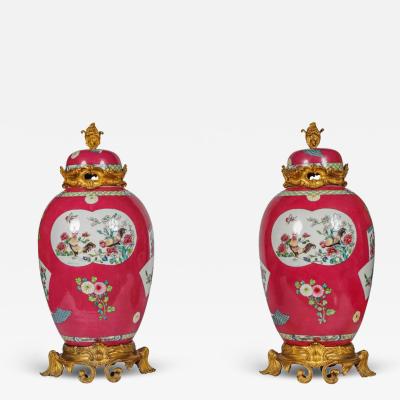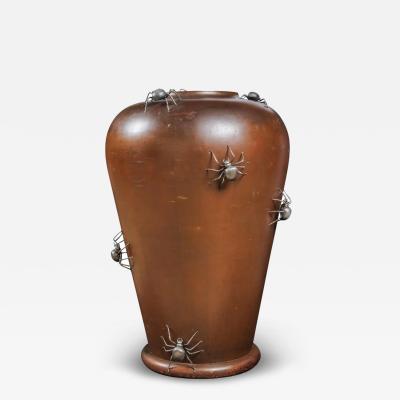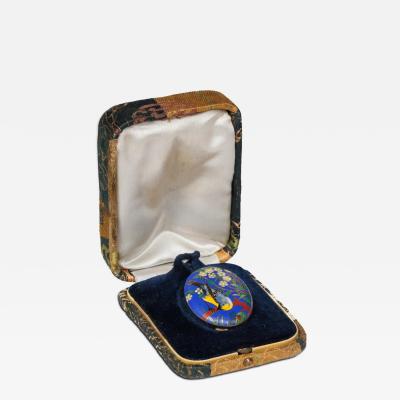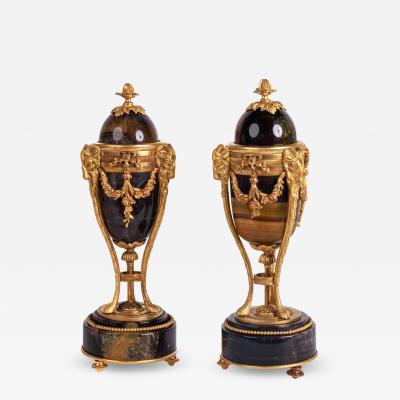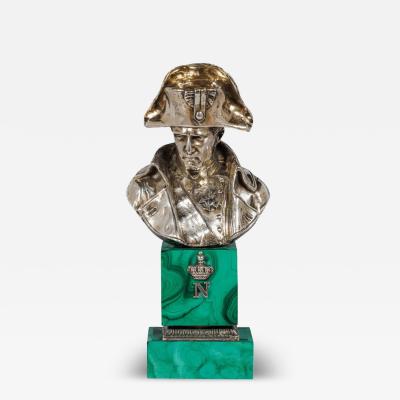Palatial & Rare Napoleon III French Ormolu and Patinated Bronze Clock, Detouche
-
Description
PRICE UPON REQUEST
A Palatial and Extremely Rare Napoleon III French Ormolu and Patinated Bronze Regulateur de Parquet Clock by Louis-Constantin Detouche, Paris, Circa 1850
n exceptional testament to the grandeur and technical mastery of 19th-century French horology, this palatial and extraordinarily rare Napoleon III ormolu and patinated bronze Regulateur de Parquet clock stands as a crowning achievement of the renowned Parisian horologist Louis-Constantin Detouche. Created circa 1850, this monumental timepiece exemplifies the perfect synthesis of artistic opulence and mechanical precision, distinguishing itself as one of the most impressive works from Detouche’s illustrious oeuvre.
At over six feet tall, this clock’s imposing scale and decorative grandeur make it an object of immense historical and aesthetic significance. The case, crafted from the finest French ormolu, features two majestic patinated bronze seated putti, serving as allegorical figures and underscoring the artistic sophistication characteristic of the Second Empire style. The white enamel dial, elegantly signed "C. Detouche/Paris," affirms its prestigious maker, while the movement, meticulously numbered 7064 and bearing the stamps "C. Detouche RUE St. MARTIN" and "C. DETOUCHE 158 R. St MARTIN 160," speaks to the highest standards of 19th-century horological craftsmanship. Further distinguishing this piece is the medaille d’argent stamp, a testament to the numerous accolades and awards bestowed upon Detouche for his innovations in timekeeping. A
Masterpiece of Horological Artistry:
Louis-Constantin Detouche was not merely a clockmaker; he was a visionary whose contributions to horology redefined precision and complexity. This particular regulator clock is an extraordinary rarity within Detouche’s body of work. While the Maison Detouche produced numerous large-scale timepieces, few of this scale and decorative refinement exist outside of museum collections and historical institutions. Most of Detouche’s other known regulators incorporate significant astronomical or electrical complications, making this purely decorative and stately example a remarkable divergence from the norm.
Comparable examples further underscore its rarity and desirability. A similarly scaled astronomical regulator of approximately 185 cm in height, dating from 1855-1860, realized $218,625 at ArtCurial, Paris, in 2007, while another mahogany-cased electric regulator clock from the Paul Garnier collection fetched $86,909 at Christie’s London in 2004. Additionally, a monumental regulator clock, dating to 1863 and donated by Detouche to the Conservatoire Impérial des Arts et Métiers de Paris (Musée des Arts et Métiers, inv. 07179-0000), remains a historical artifact of similar prestige.
Detouche: A Legacy of Excellence:
The sheer grandeur of this clock aligns with critical historical descriptions of Detouche’s exhibition pieces. Notably, a contemporary critic at the Nîmes Exhibition of 1862 lauded Detouche’s craftsmanship, remarking upon the precision, ornamentation, and accessibility of his horological works. The critic highlighted the Maison Detouche’s receipt of prestigious awards, including the gold medal at the 1860 Exposition Universelle d’Horlogerie in Besançon and the gold medal at the London Exhibition of 1862. Furthermore, Detouche’s innovations earned him the Légion d’Honneur, a recognition of his profound impact on the field of horology.
Born in 1810, Louis-Constantin Detouche continued the legacy of his father, Georges Detouche, by expanding and refining the family business. Relocating to 158-160 Rue St. Martin in 1830, he later employed Jacques François Houdin as his chef d’atelier, whose technical ingenuity significantly enhanced the firm's reputation. The Maison Detouche’s acclaim was solidified through exhibitions at the Great Exhibition of 1851, the Exposition Universelle of 1855, and various international showcases that followed.
Among his most legendary achievements is the pair of astronomical regulators, one of which was prominently displayed at the intersection of Rue Saint-Martin and Rue de Rivoli before being transferred to the prestigious collection of François-Paul Journe SA Manufacture in Geneva. These masterpieces, featuring an astonishing fourteen subsidiary dials providing celestial and meteorological information, stand as testaments to Detouche’s unparalleled craftsmanship.
Conclusion
This palatial ormolu and patinated bronze Regulateur de Parquet by Louis-Constantin Detouche is more than a timepiece—it is a sculptural marvel and a historical artifact of immeasurable value. As one of the grandest and rarest works from Detouche’s repertoire, it represents the pinnacle of Napoleon III-era horology. Its blend of masterful design, technical excellence, and monumental scale ensures its place among the most significant 19th-century French clocks, making it an unparalleled acquisition for the most discerning collectors, institutions, and connoisseurs of fine horology.
Provenance:
Exhibited at the Great London Exhibition 1851
Exhibited by Detouche at the Exposition de Nimes, 1862, where Detouche won a gold medal, the clock remarked by the jury as “un régulateur genre rocaille en bronze doré, d'un gout remarquable et d'une hauteur de 1m 90”.
By repute, formerly in the collection of the Florsheim family, Chicago Private North American collection, acquired privately early 2000s Solomon Treasure New York, where acquired from above.
Literature:
Revue Chronométrique, vol. IV, Paris, 1862, "Exposition de Nîmes - Rapport du Jury” pp. 605-609. Tardy, Dictionnaire des horlogers français, Paris, 1971-1972, pp. 182-183.
Measures: 81" high x 50" wide x 19" deep
Excellent condition. No damages noted. The glass panels on the front and back of the lower sections have been replaced by Perspex. -
More Information
Origin: France Period: 19th Century Materials: Ormolu, Bronze Condition: Good. Creation Date: 1860 Styles / Movements: Traditional, Napoleon Incollect Reference #: 308561 -
Dimensions
W. 50 in; H. 81 in; Diam. 19 in; W. 127 cm; H. 205.74 cm; Diam. 48.26 cm;
Message from Seller:
For four generations, Solomon Treasure has built a distinguished reputation for offering rare and important 18th-19th century antiques and fine art, serving museums, collectors, and designers worldwide. Located in the heart of Manhattan, we specialize in exceptional pieces ranging from Napoleon Neoclassical to Art Deco and Middle Eastern Islamic treasures. Contact: Mory Talasazan, Director | mory@solomontreasureny.com | 917.686.9732 |





